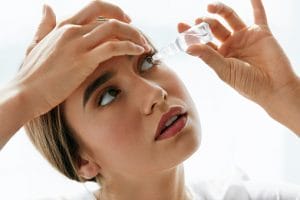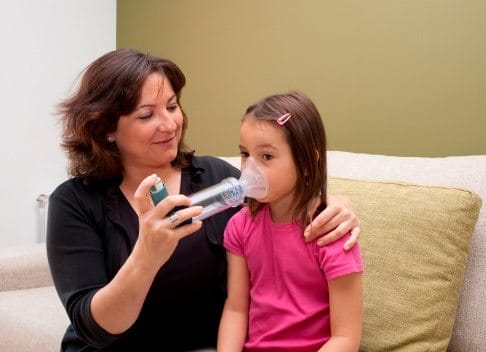
An astounding 50 million mast cells – the main cells involved in allergic response – reside in the conjunctiva, the mucus membrane covering the white part of the eye and lining the inner eyelid. When the conjunctiva get inflamed, we call it ocular allergy or allergic conjunctivitis.
Five of every six people who suffer from allergic disease report eye-related symptoms, including watery or itchy eyes, with half of those calling the disturbance moderate to severe. In the midst of allergy season, an estimated 20 percent of contact lens wearers discontinue their use.
Eye Allergy Basics
The most common medications for treating eye allergy are antihistamines, both drops and oral. Over-the-counter and prescription dual-action, antihistamine and mast cell stabilizing agent drops may provide first-line relief faster than oral antihistamines. More recently, allergists have begun recommending topical antihistamine with mast-cell stabilizers.
If symptoms persist, especially during a period of high pollen, you may benefit from using these medications for days or weeks, following an allergist visit to determine the best treatment option.
Allergic Conjunctivitis
When aeroallergens contact the eye surface, this triggers IgE antibodies, leading to inflammation. Eyes turn red and itchy, with tearing or watery discharge, and/or swelling of the lid. The most telltale symptom of allergic conjunctivitis is itching of the eye and area around it.
Seasonal allergic conjunctivitis may occur immediately to up to days or weeks following exposure. Perennial or year-round allergic conjunctivitis also may vary in its onset, depending on the volume and duration of allergic exposure. When allergic conjunctivitis meets rhinitis, it is called allergic rhinoconjunctivitis – the single most prevalent allergic disease.
Many contact lens wearers suffer from allergic conjunctivitis. Ophthalmologists often suggest switching to once-daily disposable lenses and/or preservative-free solutions, or perhaps taking a break from lenses. A once-daily ocular antihistamine drop can relieve itchy, watery and red eyes for up to 24 hours.
Eye Allergy Advice:
- Have allergy testing to determine what your allergies are, so that you can better avoid the allergens that are causing your symptoms, and thus allow more effective pre-treatment options.
- Modify your environment (e.g. use an air-conditioner and change/wash filters frequently, especially during peak season).
- With seasonal allergies, have a plan in place to pre-treat your symptoms before the season.
When Is It Eye Allergy, When Is It Not?
Other Conjunctivitis: When is it not an eye allergy? When the conjunctiva becomes red and inflamed, you may have pink eye. This is an infection, caused in most cases by a virus that may last up to a few weeks or, less frequently, it’s bacterial.
Discharge is often present, and the eyelids can be extremely swollen. Pink eye is frequently associated with a cold or respiratory infection. The bacterial kind often features a sticky, colored discharge, which can clamp the eyelids shut upon waking.
A more extreme form of allergic conjunctivitis is giant papillary conjunctivitis, or GPC, which affects those who wear contact lenses (especially soft lenses), since debris on the lens or rubbing can lead to irritation. Symptoms include tearing, mucus discharge, blurry vision, the sensation of a foreign body and difficulty tolerating contacts, and the answer is often to take a break from wearing lenses and use of medication.
Vernal Keratoconjunctivitis: This eye allergy is generally more severe than seasonal or perennial conjunctivitis. It peaks between April and August, tending to affect those more in warm, dry climates. Thickening/swelling of the conjunctiva, as well as raised bumps may occur. Again, this needs early therapeutic treatment by an eye-care practitioner.
Dry Eye: It’s possible to mistake an allergic reaction for dry eye, a common condition. Itching is less prominent in dry eye. Instead, sufferers may experience gritty, stinging, burning, dryness, irritation, light sensitivity and even blurry vision. Saline lubricant helps to maintain moisture balance and an eye-care practitioner may also prescribe drops to reduce inflammation and help to normalize tear production.
Blepharitis: This refers to chronic inflammation of the eyelids. Common symptoms include, itching, burning, irritation, tearing and stickiness, among others. A variety of reasons can be linked to the swelling: infection, insufficient hygiene, or blockage of the eyelid’s oil glands. To reduce recurrence, keep the lids clean and crust-free, use compresses and lid hygiene strategies (as instructed by your eye care practitioner) and/or modify use of eye cosmetics.
Eyelid Dermatitis: This is often caused by contact of the eyelid with allergens, particularly preservatives and fragrances found in cosmetic products or contact lens solution. Patch testing may help to identify the culprit so that the proper relief strategy can be implemented.
Related Reading:
How to Control The Itch and Blurring of Eye Allergies
Could I Have an Eye Makeup Allergy?
How Can I Manage Bad Flare-ups of Eczema on My Eyelids?
Excerpted from The New Allergy Solution: Supercharge Resistance, Slash Medication, Stop Suffering by arrangement with Avery, a member of Penguin Group (USA) LLC, A Penguin Random House Company © Clifford W. Bassett, MD. Visit Dr. Bassett’s website here.





